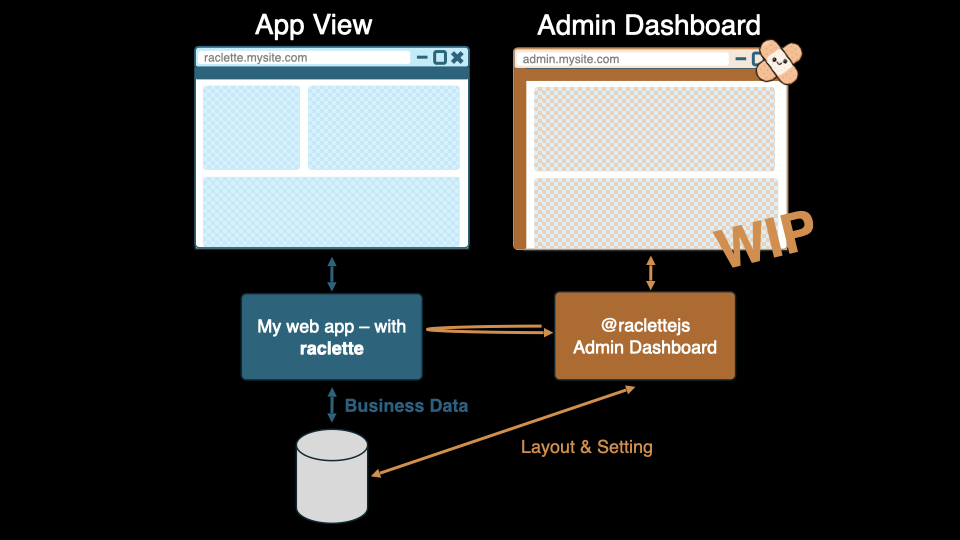Architecture Overview
raclette is built on a modular and declarative architecture that simplifies how modern business applications are structured, configured, and rendered. At the core of raclette lies a powerful engine — the Core — which handles state management, data access, user authentication, and more, while providing full flexibility to integrate with various frontend frameworks.
This document outlines the key architectural components of a raclette-based application and how they interact with one another.
Core
The raclette Core is the foundation of every raclette application. It provides:
- Authentication and session management
- A built-in MongoDB-based database layer
- A global Redux store — the heart of the application
- All relevant TypeScript types and configuration interfaces
The Core does not render any UI itself. Instead, it exposes all necessary data via the Redux store, such as:
- Which widgets should be displayed
- How the current UI is structured (via Compositions)
- Application-wide configuration and metadata
It’s this separation of data and rendering that makes raclette so flexible and extensible.
raclette Workbench
Every raclette installation includes a built-in, standalone raclette Workbench — a web-based control center used to configure and manage your raclette application without writing code.
The Workbench allows you to:
- Initialize and manage projects
- Configure UI views and layouts
- Create and assign users and permissions
- Manage tags and metadata
- Set up
InteractionLinks,Widgets, andCompositions
Essentially, anything that doesn't require code changes can be configured here.
Orchestrator
The Orchestrator is a customizable project that sits on top of the raclette Core. Its main job is to:
- Connect the Core to a specific UI framework (e.g., React, Vue, Svelte, Angular)
- Decide how the application UI is rendered based on the data provided by the Core
- Control the rendering logic of the frontend layer
- Handle custom behavior and project-specific logic
By separating rendering concerns into the Orchestrator, raclette offers full flexibility and UI framework independence.
Widgets
Widgets are the smallest composable units in raclette. Each widget combines:
- A visual UI component
- Its business logic and state configuration
Widgets can range from simple buttons to complex data tables or input forms. They are fully reusable and self-contained, making it easy to manage even large, complex views.
Compositions
A Composition defines the structure and content of a view. It describes:
- Which widgets are displayed
- How they are laid out on the screen
- Any logical relationships between them
Compositions are fully declarative. They act as blueprints for screens, making views easy to define, configure, and modify — without hardcoding layout logic.
InteractionLinks
InteractionLinks define how and when Compositions are triggered. They capture user interactions and describe:
- The context of the interaction (e.g., current user, current view)
- What Composition should be shown
- Which parameters should be passed
- How the transition is handled (modal, navigation, etc.)
InteractionLinks abstract away manual wiring of events. Instead, you declare what should happen, and raclette takes care of the rest.
Global Store
At the center of everything is raclette’s global Redux store. It is the single source of truth for the application state and provides:
- Visibility into active Widgets and Compositions
- Access to global configuration, metadata, and context
- Consistent and predictable state management
All parts of the system — including the raclette Workbench, Orchestrator, and UI components — read from and write to this store.
This allows for powerful features like:
- State-driven navigation
- Dynamic rendering
- Reactive data flows
Backend Integration
The Core includes an integrated backend layer that provides:
- Authentication & authorization
- MongoDB for structured and unstructured data storage
- API endpoints for data access
- A plug-and-play model for backend extension
This backend layer is fully extensible but ready to use out-of-the-box, so you can focus on building business logic rather than implementing infrastructure from scratch.
Summary
raclette provides a clear separation of concerns between configuration, logic, and rendering. The architecture can be visualized as:
